How Do Earthworms Affect Forest Soils?
It seems to be common knowledge to most of us, that earthworms are good for soils. When asked, most people express something along the lines that earthworms are good because they “mix and aerate soil” and “increase nutrients”. This concept likely comes from decades of research on the positive impacts of earthworm activity in gardens and farm fields where the soil can become compacted and less productive if it isn't broken up and organic material isn’t mixed in. But hardwood forests in the Great Lakes region developed for thousands of years since glacial retreat without any earthworms. The natural processes in these earthworm-free forests usually keep the soil loose and uncompacted. Hardwood trees produce tons of nutrient rich leaf litter each year. When leaf litter is produced faster than it decomposes, you can see the development of a thick forest floor, and beneath that forest floor a unique set of soil layers also develops… read more. As litter in the forest floor is decomposed by bacteria and fungi, nutrients are made available for understory plants and tree seedlings. The thick forest floor of earthworm-free hardwood forests turns out to be a central feature of these ecosystems since it is where most nutrient cycling occurs and where virtually all understory plants and tree seedling germinate and grow. When earthworms invade, the hardwood forest ecosystem begins to change rapidly as this forest floor is removed.
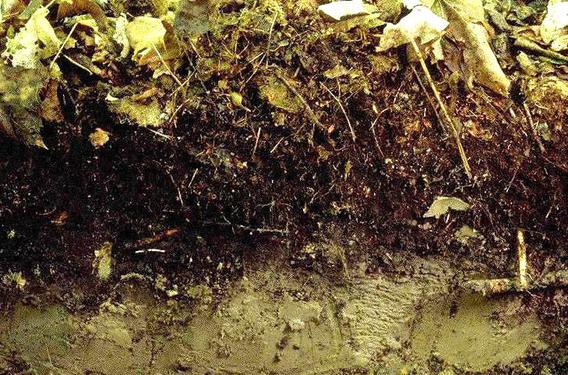 |
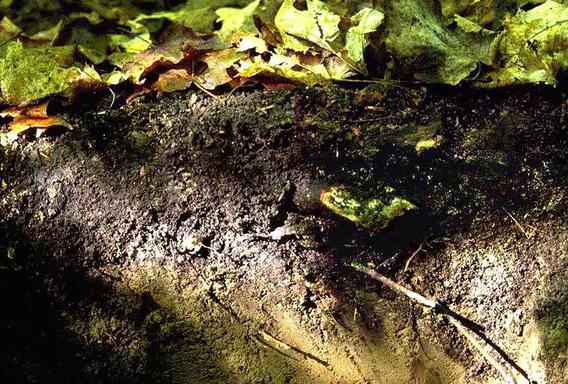 |
How Do Earthworms Change the Forest Floor?
In forest ecosystems, the forest floor is where the action is. In hardwood forests, this is particularly true because the thick “duff” layer holds a lot of moisture and acts like a mulch for the forest. The combination of moisture and shade from the canopy create a generally cool and stable microclimate for plants and animals that can be very different than temperature and moisture conditions in open spaces nearby. Many plants and animals rely on this microclimate for their survival. In winter, the forest floor acts as a blanket that helps protect organisms from freezing conditions. Most of the plants and animals living in this layer have adapted to survive and grow in the particular conditions of the forest floor. Big changes in the forest floor could mean big changes for all the organisms that depend on a stable hardwood forest ecosystem.
When earthworms invade, they remove the forest floor by eating it and by mixing it into the upper mineral soil horizon… read more. As a result, all of the processes that used to occur in the forest floor have been moved into the upper mineral soil layers. Many of the organisms that used to live in the forest floor have lost their habitat, including food sources. They will either leave or die trying to find another habitat they can live in. Plant roots have a harder time growing in the new dense A horizon than they did in the O horizon which was loose and spongy. Without the forest floor to insulate the soil, it will get warmer and drier in the summer and colder in the winter. These conditions may make it difficult for plants and animals that are adapted to the particular conditions of the forest floor to survive following earthworm invasion.
Read more about how animals are affected by earthworm invasion.
Read more about how plants are affected by earthworm invasion.
Let's take a look at some of the components and functions of the forest floor and how they may change when earthworms invade:
Plant roots
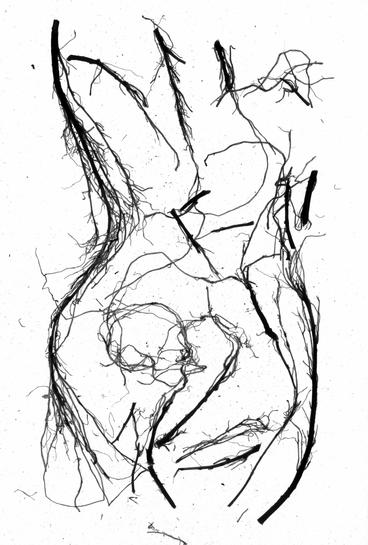
Plant roots grow densely in the forest floor because of the high concentration of nutrients and its loose spongy texture. Very few roots extend below the forest floor. The ones that do are usually for anchoring large plants as opposed to taking up nutrients and water. Besides the fine roots used to take up nutrients, many forest plants also use their roots to store food and reproduce. Perennial plants, for example, store food in different kinds of fleshy roots called bulbs, rhizomes, or corms. As they grow, the bulbs or rhizomes will spread and divide, growing new plants in a process called vegetative reproduction.
Plant roots, especially fine roots, do not grow as densely in the new A horizon as they did in the forest floor. As a result, the remaining plants may become stressed more easily when the weather turns warm and dry. With fewer fine roots to take up nutrients in the soil, plants with poor root systems may not be able to get to the nutrients with the same efficiency. In addition, the tiny roots that plants use to absorb nutrients and water can easily get damaged by earthworms grazing in the rhizosphere (the soil surrounding roots). Earthworms many not want to eat the root itself, but they like to eat the bacteria and fungi close to the roots. Earthworms can also cause damage to the bulbs, rhizomes or corms that native perennial plants use to store food. When these fleshy roots are damaged and the stored food is lost or used up, the plant can decline slowly over several years until it simply dies. Add to this the fact that soil nutrient availability actually goes down after earthworms invade and you can see how plants may suffer because of the changes in forest soils after earthworm invade.
Read more about how earthworms affect decomposition and nutrient cycling.
Fungi
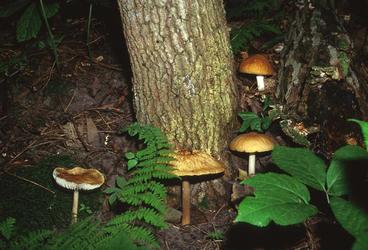
Fungi grow densely in the forest floor and there are more species than have been identified. Fungi are not green because they don't have chlorophyll and therefore do not produce their own food through photosynthesis. Instead, fungi must get the sugars and carbohydrates they need from other sources. Saprophytic fungi get their food by decomposing dead plant material. Mushrooms growing on a dead log are an example of this. Mycorrhizal fungi work in partnership with green plants to get the food they need. In this symbiotic relationship, the fungi help the plants get nutrients and water and in return the plants give the fungi food… read more. Most hardwood forest plants, including the trees, have mycorrhizae associated with their roots. Some forests plants, such as orchids, are completely dependent on mycorrhizal fungi and cannot survive without them. If earthworm invasion leads to changes in the mycorrhizal community of fungi, the diversity of plants that make up the understory would be dramatically changed.
Fungi are a preferred food of many earthworm species and they graze it heavily, which could dramatically impact the abundance and composition of fungi in the soil. By grazing fungi on or near plant roots, the earthworms not only can damage the roots, but they prevent the plant and fungi from forming the symbiotic relationship where mycorrhizal fungi exchange nutrients and water for carbohydrates with green plants. If the fungi can't get enough food, they will die back even further. For some of the native plants that need mycorrhizal fungi, especially when the plant is young and small, survival will be difficult if earthworms prevent this relationship from being formed.
Bacteria

Bacteria are present in the forest floor and soils in amazing amounts and by thousands of species. Before and after earthworm invasion, bacteria are important organisms that decompose litter, producing nutrients that plants can use. However, after earthworm invasion, the composition of the bacterial community changes, their biomass can increase as can their activity levels. In addition, a great deal of bacterial activity takes place in the earthworm gut and cast material is charged with the bacteria from the earthworm gut leading to changes in the species of bacteria dominant in the forest soils.
Seeds
Seeds are deposited by plants into the forest floor. Because the forest floor is made up of loose, organic material such as leaf litter, many of the seeds are protected from predation by small mammals and birds. Also, because the forest floor is moist and full of nutrients, the seeds have a perfect place to germinate. The forest floor and the protection it provides is especially important for some herbaceous plants because their seeds germinate slowly, taking two or more years to develop into a small plant. If not protected from predators, drying out or freezing over a long period of time, the seeds would have no chance of growing into a mature plant.
Seeds produced by mature plants that survive the disturbance of initial earthworm invasion are no longer protected by the forest floor from predation by seed eating animals or from the annual drying and freezing common in northern climates. Earthworms also consume seeds which can decrease their viability or lead to deep burial in the soil. If the seeds survive to germinate, they are no longer protected by a forest floor from moisture temperature extremes. The newly germinated seeds may be more vulnerable to death, especially native herbaceous plants that germinate very slowly, taking two or more years to grow into a small plant. Seeds that one buys in a garden store will generally germinate when you plant them in the soil. In a hardwood forest ecosystem, most native plant seeds don't germinate until they go through a freezing and warming cycle (winter and summer) at least once and sometimes twice before growing into a small plant. The forest floor protects these seeds and tiny plants from predators and extremes in temperature and moisture, making the loss of the forest floor devastating to native plant production.
Leaves and twigs
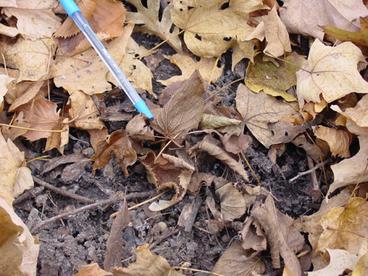
Leaves and twigs fall to the forest floor creating a thick “duff” layer on top of the mineral soil. If you dissect the layers of leaves and twigs in the forest floor, the youngest leaves on top are typically brown and easy to identify the species of plant they came from. However, as one goes deeper, the leaves begin to turn black and are broken apart making species identification difficult or impossible. At the deepest layer of the forest floor, the leaves and twigs have decomposed to the point that they are not even distinguishable as leaves or twigs. The decomposition of leaves and twigs by bacteria and fungi is the primary source of nutrients in the forest and the cycling of these nutrients is critical to maintaining the health of the forest
After earthworm invasion, leaves and twigs continue to fall to the forest floor each year but are rapidly eaten by the earthworms. Thus the forest floor never redevelops. Currently there are no methods for removing earthworm once they colonize a site. So, the functions previously provided by the forest floor are never restored. While the short-term effects on the forest floor, soils and plant communities are quite visibly striking, little is known about the long-term effects of earthworm invasion on forest ecosystems decades after initial invasion.
Read more about how earthworms affect decomposition and nutrient cycling.
Read more about what you can do about earthworm invasions.
Logs
Logs fall to the forest floor and decompose very slowly. Dead fall, or logs, contain a great deal of nutrients and are home to a number of insects, fungi, and bacteria. The older and more rotted logs often have a layer of moss and other plants growing on them. As a log ages and decomposes, it sinks deeper and deeper into the forest floor, providing habitat for amphibians such as salamanders and small mammals like red-backed voles. The log not only provides protection and moisture for these animals but also food in the form of insects and fungi. A log can be a habitat onto itself for some creatures.
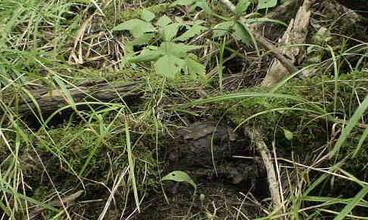 |
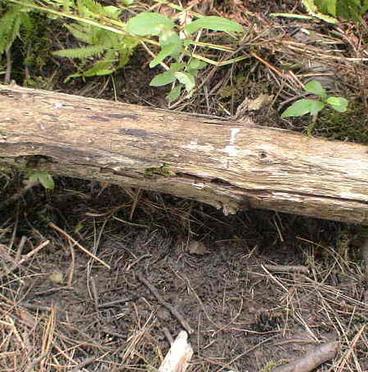 |
Earthworms do not eat logs directly, but once the forest floor is gone, logs can begin to dry out and get hard making it difficult for insects to burrow into them. As the logs dry, their decomposition slows because and the log no longer provides the moisture that wood decaying bacteria and fungi need. As the populations of insects and fungi decline on a log, so do the food resources for many other forest animals. The mosses and other plants that require moist decaying wood to survive may also die back if the log has dried out. Tip-up mounds, the stump & root of a tree that has toppled over with the soil still clinging to it, are sometimes the only part of a fallen tree that contains enough moisture for decomposition to continue and for plants to colonize it after earthworms remove the forest floor.
Next time you go for a walk in the forest, take a closer look at the logs there and see if you have a healthy ecosystem supported by logs or mostly dry, less lively logs.
Decomposition
If you have a compost pile, then decomposition is a familiar occurrence. On the top of the pile, leaves and other stuff are easily identifiable but as you work your way down to the bottom of the pile, things become more moist, black in color and less distinguishable as to what their original form was. Within your compost pile hundreds (perhaps millions) of different kinds of bacteria and fungi living in a single handful of compost. It is the action of these microscopic creatures that makes decomposition happen.
The process of decomposition converts nutrients from organic forms (molecules that plants cannot use) to mineral forms (molecules that plants can use) and has two major parts called immobilization and mineralization. In immobilization, soil fungi and bacteria take up soil nutrients (like nitrogen and phosphorous) that they need to break down organic material. During mineralization, bacteria and fungi release nutrients in forms that plants can take up (for example, NO3 = nitrate, NH4 = ammonium, and PO4 = phosphate). A good example of this two part process can be observed in compost piles. If leaves, grass clippings and vegetable kitchen scraps are composted (broken down by fungi and bacteria) the black mixture that results can be added to the garden and your plants will respond by taking up the available nutrients* because the well decomposed material is in the mineralization phase, where it releases more available nutrients than it takes up. However, if the leaves, grass clipping and vegetable scraps were thrown directly into the garden, the garden plants would obviously not be able to take up the nutrients present in these food scraps immediately. In fact, the scraps may sit on the soil for some time, absorbing nutrients from the soil (immobilization), before they break down. So, the early phase of a compost pile, when things are just starting to decompose is the immobilization phase when more nutrients are being used by the fungi and bacteria than are being released. The nutrients that plants need are present within the uncomposted material but in forms that are not yet available to be taken up by plants. The same process of decomposition occurs everywhere across the planet. If it weren't for bacteria and fungi, organic matter in the forest would not get broken down and eventually the forest would run out of nutrients. But forests and other ecosystems do not run out of nutrients, because those nutrients are continually recycled in a process called nutrient cycling.
What do you mean by “available” nutrients? Nitrogen and phosphorous are atoms that can be found in any number of different molecules. Living organisms need these atoms because they are important parts of proteins and enzymes that make living things function properly. The earth’s atmosphere is composed of over 75% nitrogen in the form of nitrogen gas (N2). But most plants cannot absorb atmospheric nitrogen directly (those that can are called nitrogen fixers). Most plants need to absorb the nitrogen they need from the soil in the water soluble forms of nitrate (NO3) and ammonium (NH4). The total amount of nitrogen in the form of nitrates and ammonium are referred to as “available nitrogen”. Because nitrogen can be present in many organic molecules in the soil the total amount of nitrogen in the soil might be much higher than the total “available nitrogen”, an important distinction (see the Research Methods section for discussion on how these measurements are made). Soil microorganisms (fungi and bacteria) do the job of converting nitrogen in organic molecules to these “available” forms, also referred to as “mineral forms”.
When earthworms invade a hardwood forest they increase the rate at which litter disappears. They do this in two ways. First, earthworms break up the litter into tiny pieces and mix it into the mineral soil below (fragmentation and burial) where fungi and bacteria can get access to it and can start to break it down (immobilization). Second, fragmentation and burial of organic matter increases the rate of decomposition by fungi and bacteria (mineralization starts faster). Imagine eating a tootsie roll sucker and your favorite part is the chewy center. To get to the chewy center, you would have to eat through the hard candy exterior. Bacteria and fungi prefer the "center" of the litter (sugars and carbohydrates) found on the forest floor but first have to get through the fiber (lignin and cellulose). If you imagine licking your way to the center of a tootsie roll, it would be much slower than biting through the hard candy exterior. Likewise, it takes time for bacteria and fungi to get through the fiber, but when earthworms are present they speed up this process. Earthworms act as the teeth and expose the sugars and carbohydrates to the bacteria and fungi, allowing for a relatively quick breakdown of the litter compared to when bacteria and fungi consume the litter alone. The end result is that litter will be disappear faster than it is produced after earthworm invade, while under earthworm-free conditions, the rate of accumulation was slightly faster than the rate of disappearance.
Nutrients and Nutrient Cycling
In an earthworm-free hardwood forest, the cycling of nutrients is mostly closed, which means that the rate of decomposition and nutrient release is very closely matched by the rate of uptake by plants. Many hardwood forest native plants are adapted to take up nutrients readily in the spring and then more gradually throughout the rest of the season. This pattern of uptake more closely matches the pattern of nutrient availability in an earthworm-free forest, where there is a large pulse of available nutrients with spring thaw. Because of this balance between nutrient release and plant absorption, there is little to no loss of nutrients from the forest ecosystem.
After earthworm invasion, nutrients previously in the forest floorare 1) relocated to the A horizon and 2) more rapidly converted to forms that plants can take up (mineralization). The earthworm casts in the new A horizon don't have more nutrients than the forest floor did (since it came from the forest floor, it couldn't) but as the litter passes through the earthworm gut, it gets broken up and colonized by fungi and bacteria. So, more of the nutrients from the litter are converted to forms that plants can easily absorb through their roots… read more below. Although the total amount of a given nutrient does not increase, earthworms can increase the proportion of total nutrients made available to plants at any given time. That’s why you so often hear how earthworms increase soil fertility, because they turn more of the nutrients present in a site into a form that plants can take up. In agricultural ecosystems, crop plants are well adapted to take up nutrients rapidly so earthworms often lead to increased plant growth. But in forest ecosystems, things work a little differently.
After earthworms invade a hardwood forests, the rate of decomposition and nutrient release is faster than the rate of uptake by plants and some of these nutrients are lost through the process of leaching. The end result is that both nitrogen and phosphorous availability decreases in hardwood forests after earthworm invasion. Native plants of hardwood forests are not as well adapted to take up large amounts of nutrients throughout the growing season and when nutrients are in forms that plants can absorb, they are also easily leached through the soil with water. Two things increase the likelihood of nutrient leaching. First, there are not enough plants or root systems to absorb the amount of nutrients available. Second, with all of those earthworm burrows, water can wash the dissolved nutrients down through the soil, below the plant roots or out into adjacent wetlands, rivers and streams. Nutrients that would have been cycled within the hardwood forest ecosystem can either be lost underground or transferred out to another system.
Read more about how a forest ecosystem works.
Limiting Nutrients
While all organisms need a wide variety of nutrients to live, there are a few that are particularly limiting for plants. A limiting nutrient is one that the plant needs to live, but the supply is less than the amount the plant could use, so the growth of the plant is “limited” by the amount of that particular nutrient.
For land plants, two nutrients are often limiting, nitrogen and phosphorous (that’s why these are the two most common nutrients in plant fertilizers!). But nitrogen and phosphorous can come in many forms, different molecules, some of which can be taken up by plants and some that cannot. For example, nitrogen and phosphorous are common components in proteins and enzymes of plants and animals. But a plant root cannot absorb proteins directly. Nitrogen is taken up by plants in the forms of NO3 = nitrate and NH4 = ammonium. Phosphorous is taken up by plants in the form of PO4 = phosphate. Only nitrogen and phosphorous in these forms are “available nutrients” to plants. So only a portion of the “total nitrogen” or “total phosphorous” found in the soil is actually “available” at any given time.
For more details on the ecology of soils and their organisms see The “Soil Biology Primer” by the Natural Resources Conservation Service